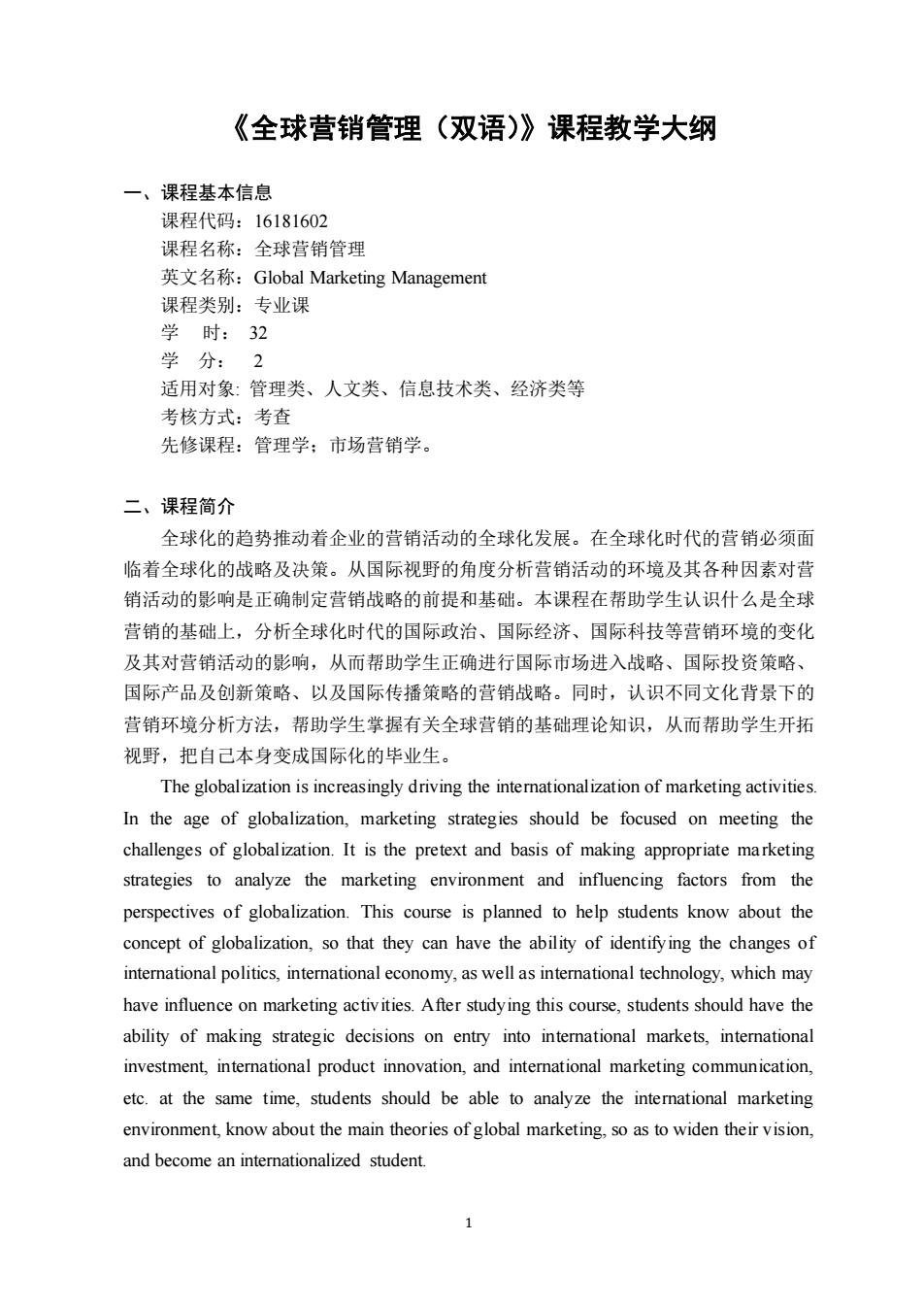
《全球营销管理(双语)》课程教学大纲 一、课程基本信息 课程代码:16181602 课程名称:全球营销管理 英文名称:Global Marketing Management 课程类别:专业课 学时:32 学分:2 适用对象:管理类、人文类、信息技术类、经济类等 考核方式:考查 先修课程:管理学:市场营销学。 二、课程简介 全球化的趋势推动着企业的营销活动的全球化发展。在全球化时代的营销必须面 临着全球化的战略及决策。从国际视野的角度分析营销活动的环境及其各种因素对营 销活动的影响是正确制定营销战略的前提和基础。本课程在帮助学生认识什么是全球 营销的基础上,分析全球化时代的国际政治、国际经济、国际科技等营销环境的变化 及其对营销活动的影响,从而帮助学生正确进行国际市场进入战略、国际投资策略、 国际产品及创新策略、以及国际传播策略的营销战略。同时,认识不同文化背景下的 营销环境分析方法,帮助学生掌握有关全球营销的基础理论知识,从而帮助学生开拓 视野,把自己本身变成国际化的毕业生。 The globalization is increasingly driving the intemationalization of marketing activities. In the age of globalization,marketing strategies should be focused on meeting the challenges of globalization.It is the pretext and basis of making appropriate marketing strategies to analyze the marketing environment and influencing factors from the perspectives of globalization.This course is planned to help students know about the concept of globalization,so that they can have the ability of identifying the changes of international politics,international economy,as well as interational technology,which may have influence on marketing activities.After studying this course,students should have the ability of making strategic decisions on entry into intemational markets,intemnational investment,international product innovation,and international marketing communication, etc.at the same time,students should be able to analyze the international marketing environment,know about the main theories of global marketing,so as to widen their vision, and become an internationalized student. 1
1 《全球营销管理(双语)》课程教学大纲 一、课程基本信息 课程代码:16181602 课程名称:全球营销管理 英文名称:Global Marketing Management 课程类别:专业课 学 时: 32 学 分: 2 适用对象: 管理类、人文类、信息技术类、经济类等 考核方式:考查 先修课程:管理学;市场营销学。 二、课程简介 全球化的趋势推动着企业的营销活动的全球化发展。在全球化时代的营销必须面 临着全球化的战略及决策。从国际视野的角度分析营销活动的环境及其各种因素对营 销活动的影响是正确制定营销战略的前提和基础。本课程在帮助学生认识什么是全球 营销的基础上,分析全球化时代的国际政治、国际经济、国际科技等营销环境的变化 及其对营销活动的影响,从而帮助学生正确进行国际市场进入战略、国际投资策略、 国际产品及创新策略、以及国际传播策略的营销战略。同时,认识不同文化背景下的 营销环境分析方法,帮助学生掌握有关全球营销的基础理论知识,从而帮助学生开拓 视野,把自己本身变成国际化的毕业生。 The globalization is increasingly driving the internationalization of marketing activities. In the age of globalization, marketing strategies should be focused on meeting the challenges of globalization. It is the pretext and basis of making appropriate ma rketing strategies to analyze the marketing environment and influencing factors from the perspectives of globalization. This course is planned to help students know about the concept of globalization, so that they can have the ability of identifying the changes of international politics, international economy, as well as international technology, which may have influence on marketing activities. After studying this course, students should have the ability of making strategic decisions on entry into international markets, international investment, international product innovation, and international marketing communication, etc. at the same time, students should be able to analyze the international marketing environment, know about the main theories of global marketing, so as to widen their vision, and become an internationalized student
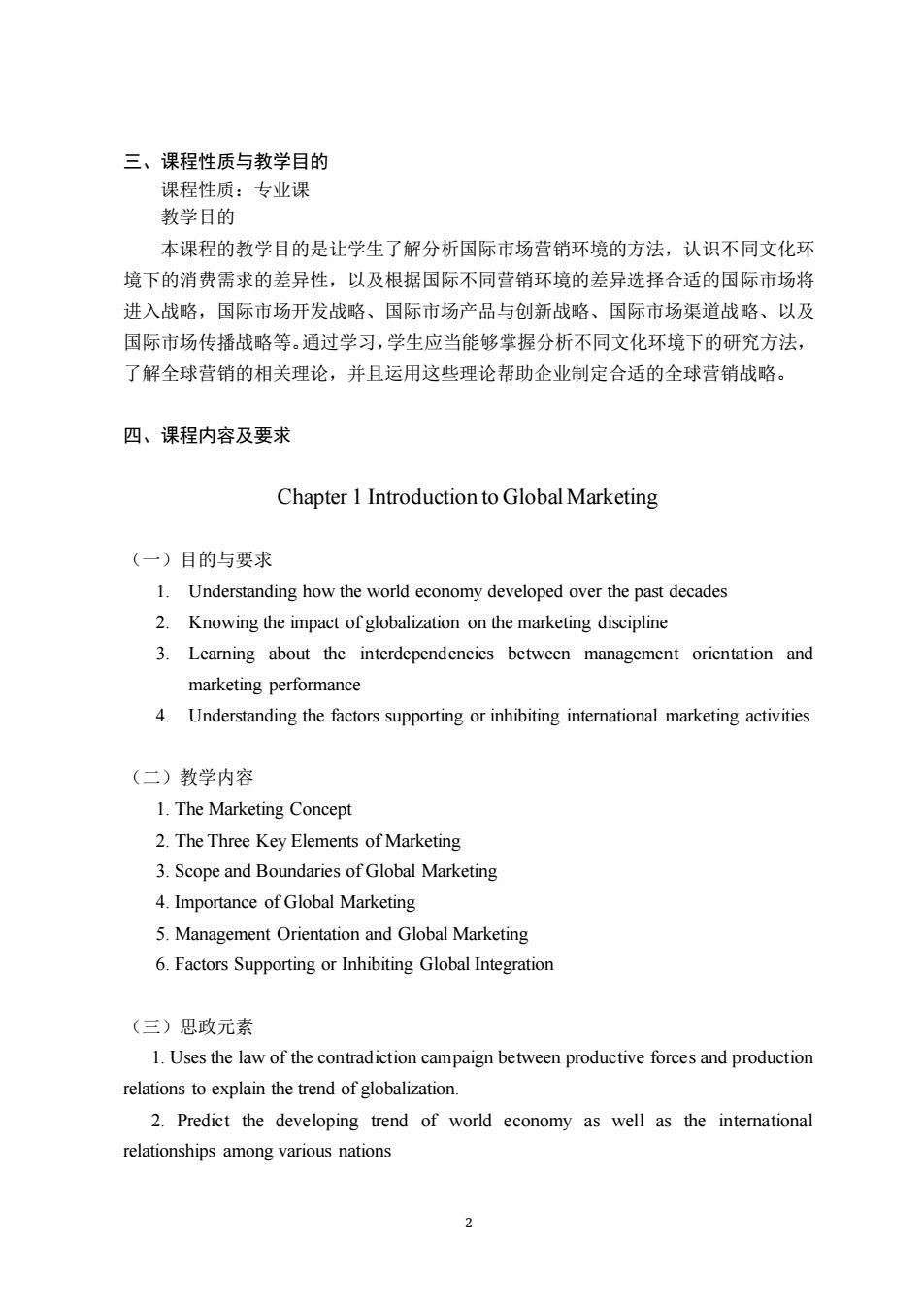
三、课程性质与教学目的 课程性质:专业课 教学目的 本课程的教学目的是让学生了解分析国际市场营销环境的方法,认识不同文化环 境下的消费需求的差异性,以及根据国际不同营销环境的差异选择合适的国际市场将 进入战略,国际市场开发战略、国际市场产品与创新战略、国际市场渠道战略、以及 因际市场传播战略等。通过学习,学生应当能够掌握分析不同文化环境下的研究方法, 了解全球营销的相关理论,并且运用这些理论帮助企业制定合适的全球营销战略。 四、课程内容及要求 Chapter I Introduction to Global Marketing (一)目的与要求 1.Understanding how the world economy developed over the past decades 2.Knowing the impact of globalization on the marketing discipline 3.Learning about the interdependencies between management orientation and marketing performance 4. Understanding the factors supporting or inhibiting intemational marketing activitie (二)教学内容 1.The Marketing Concept 2.The Three Key Elements of Marketing 3.Scope and Boundaries of Global Marketing 4.Importance of Global Marketing 5.Management Orientation and Global Marketing 6.Factors Supporting or Inhibiting Global Integration (三)思政元素 1.Uses the law of the contradiction campaign between productive forces and production relations to explain the trend of globalization. 2.Predict the developing trend of world economy as well as the international relationships among various nations 2
2 三、课程性质与教学目的 课程性质:专业课 教学目的 本课程的教学目的是让学生了解分析国际市场营销环境的方法,认识不同文化环 境下的消费需求的差异性,以及根据国际不同营销环境的差异选择合适的国际市场将 进入战略,国际市场开发战略、国际市场产品与创新战略、国际市场渠道战略、以及 国际市场传播战略等。通过学习,学生应当能够掌握分析不同文化环境下的研究方法, 了解全球营销的相关理论,并且运用这些理论帮助企业制定合适的全球营销战略。 四、课程内容及要求 Chapter 1 Introduction to Global Marketing (一)目的与要求 1. Understanding how the world economy developed over the past decades 2. Knowing the impact of globalization on the marketing discipline 3. Learning about the interdependencies between management orientation and marketing performance 4. Understanding the factors supporting or inhibiting international marketing activities (二)教学内容 1. The Marketing Concept 2. The Three Key Elements of Marketing 3. Scope and Boundaries of Global Marketing 4. Importance of Global Marketing 5. Management Orientation and Global Marketing 6. Factors Supporting or Inhibiting Global Integration (三)思政元素 1. Uses the law of the contradiction campaign between productive forces and production relations to explain the trend of globalization. 2. Predict the developing trend of world economy as well as the international relationships among various nations
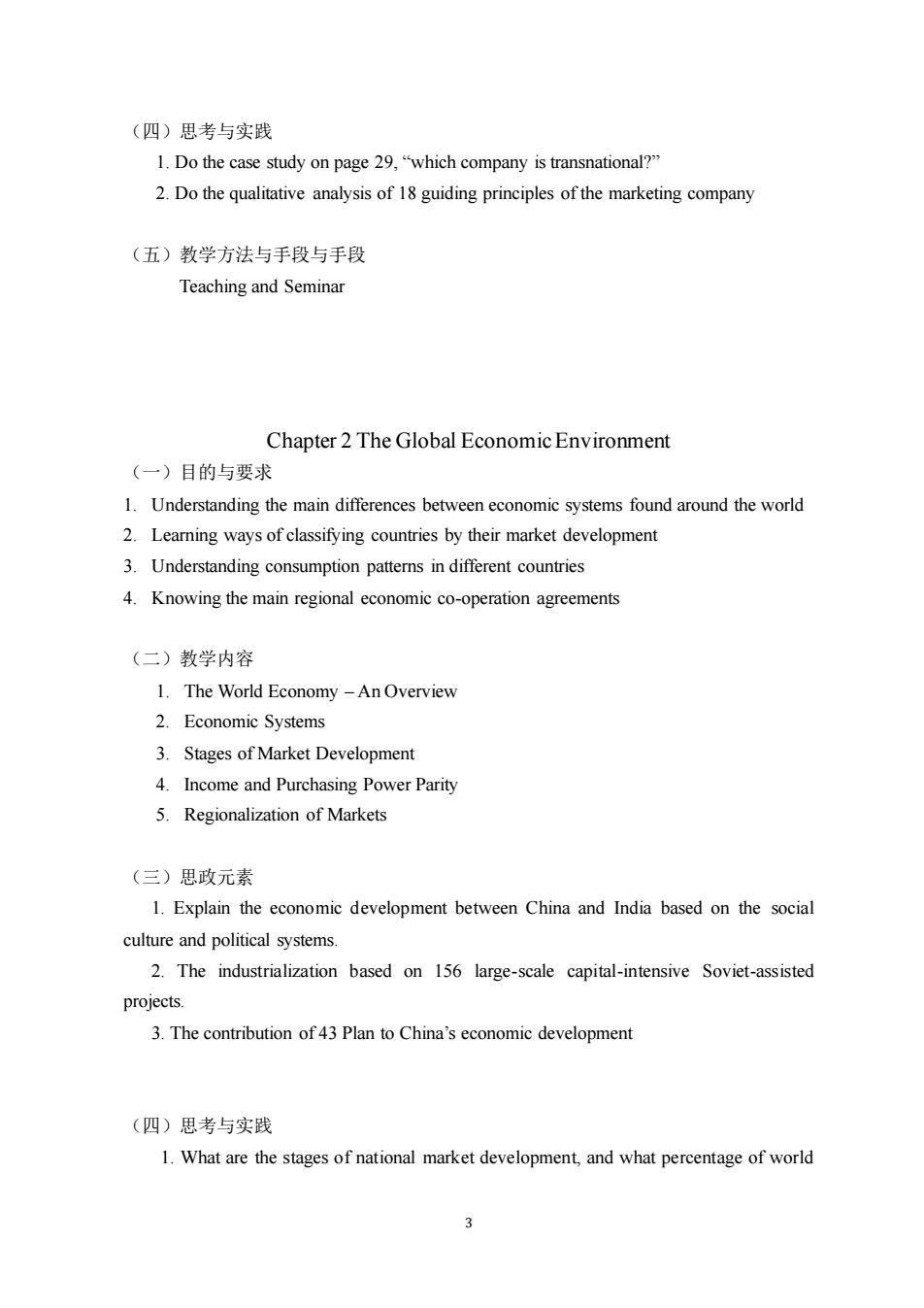
(四)思考与实践 1.Do the case study on page 29,which company is transnational?" 2.Do the qualitative analysis of 18 guiding principles of the marketing company (五)教学方法与手段与手段 Teaching and Seminar Chapter 2 The Global Economic Environment (一)目的与要求 1.Understanding the main differences between economic systems found around the world 2.Learning ways of classifying countries by their market development 3.Understanding consumption patters in different countries 4.Knowing the main regional economic co-operation agreements (二)教学内容 1.The World Economy-An Overview 2.Economic Systems 3.Stages of Market Development 4.Income and Purchasing Power Parity 5.Regionalization of Markets (三)思政元素 1.Explain the economic development between China and India based on the social culture and political systems 2.The industrialization based on 156 large-scale capital-intensive Soviet-assisted projects. 3.The contribution of 43 Plan to China's economic development (四)思考与实践 1.What are the stages of national market development,and what percentage of world 3
3 (四)思考与实践 1. Do the case study on page 29, “which company is transnational?” 2. Do the qualitative analysis of 18 guiding principles of the marketing company (五)教学方法与手段与手段 Teaching and Seminar Chapter 2 The Global Economic Environment (一)目的与要求 1. Understanding the main differences between economic systems found around the world 2. Learning ways of classifying countries by their market development 3. Understanding consumption patterns in different countries 4. Knowing the main regional economic co-operation agreements (二)教学内容 1. The World Economy – An Overview 2. Economic Systems 3. Stages of Market Development 4. Income and Purchasing Power Parity 5. Regionalization of Markets (三)思政元素 1. Explain the economic development between China and India based on the social culture and political systems. 2. The industrialization based on 156 large-scale capital-intensive Soviet-assisted projects. 3. The contribution of 43 Plan to China’s economic development (四)思考与实践 1. What are the stages of national market development, and what percentage of world
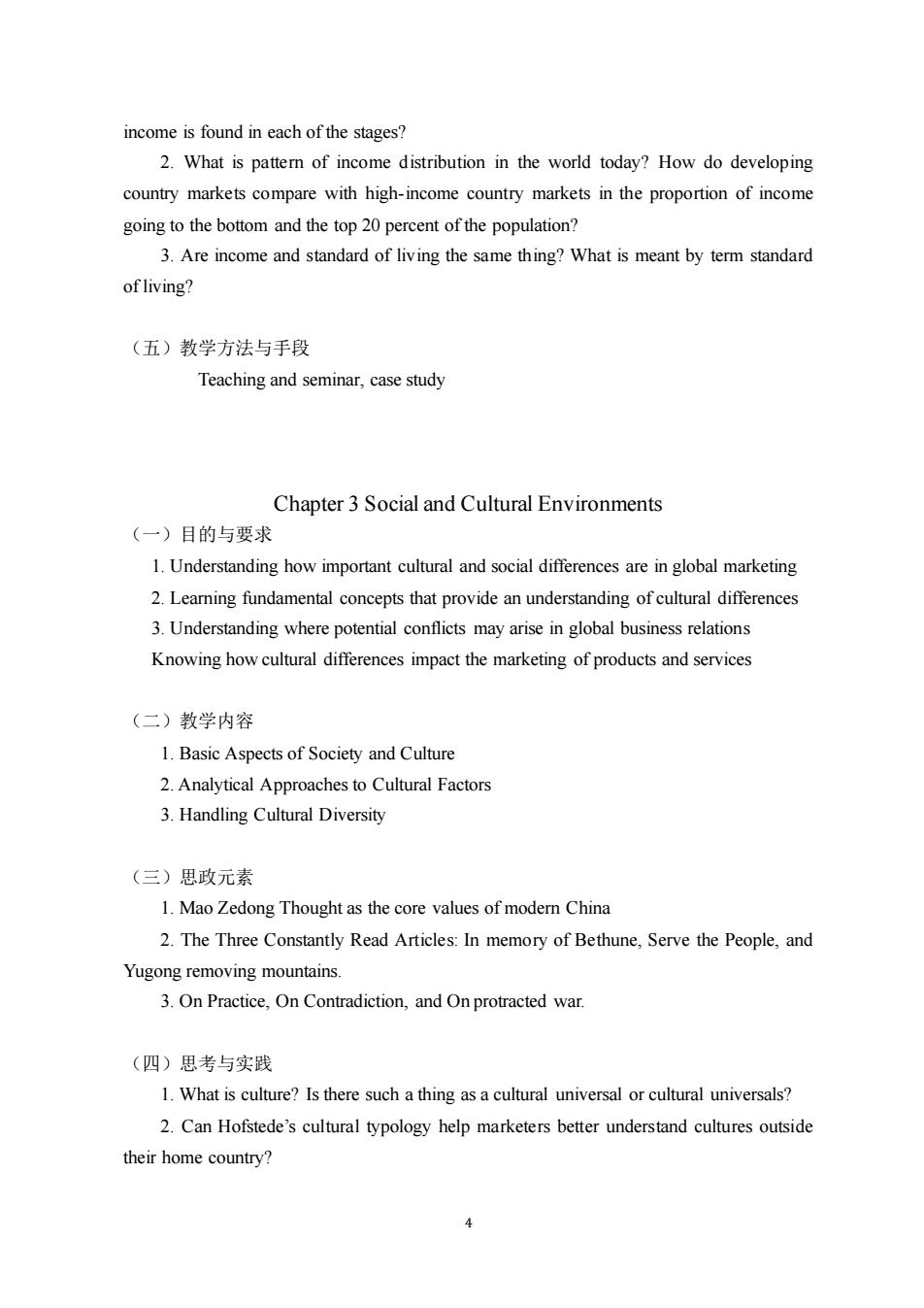
income is found in each of the stages? 2.What is pattem of income distribution in the world today?How do developing country markets compare with high-income country markets in the proportion of income going to the bottom and the top 20 percent of the population? 3.Are income and standard of living the same thing?What is meant by term standard of living? (五)教学方法与手段 Teaching and seminar,case study Chapter 3 Social and Cultural Environments (一)目的与要求 1.Understanding how important cultural and social differences are in global marketing 2.Leaming fundamental concepts that provide an understanding of cultural differences 3.Understanding where potential conflicts may arise in global business relations Knowing how cultural differences impact the marketing of products and services (二)教学内容 1.Basic Aspects of Society and Culture 2.Analytical Approaches to Cultural Factors 3.Handling Cultural Diversity (三)思政元素 1.Mao Zedong Thought as the core values of modem China 2.The Three Constantly Read Articles:In memory of Bethune,Serve the People,and Yugong removing mountains 3.On Practice,On Contradiction,and On protracted war. (四)思考与实践 1.What is culture?Is there such a thing as a cultural universal or cultural universals? 2.Can Hofstede's cultural typology help marketers better understand cultures outside their home country? 4
4 income is found in each of the stages? 2. What is pattern of income distribution in the world today? How do developing country markets compare with high-income country markets in the proportion of income going to the bottom and the top 20 percent of the population? 3. Are income and standard of living the same thing? What is meant by term standard of living? (五)教学方法与手段 Teaching and seminar, case study Chapter 3 Social and Cultural Environments (一)目的与要求 1. Understanding how important cultural and social differences are in global marketing 2. Learning fundamental concepts that provide an understanding of cultural differences 3. Understanding where potential conflicts may arise in global business relations Knowing how cultural differences impact the marketing of products and services (二)教学内容 1. Basic Aspects of Society and Culture 2. Analytical Approaches to Cultural Factors 3. Handling Cultural Diversity (三)思政元素 1. Mao Zedong Thought as the core values of modern China 2. The Three Constantly Read Articles: In memory of Bethune, Serve the People, and Yugong removing mountains. 3. On Practice, On Contradiction, and On protracted war. (四)思考与实践 1. What is culture? Is there such a thing as a cultural universal or cultural universals? 2. Can Hofstede’s cultural typology help marketers better understand cultures outside their home country?
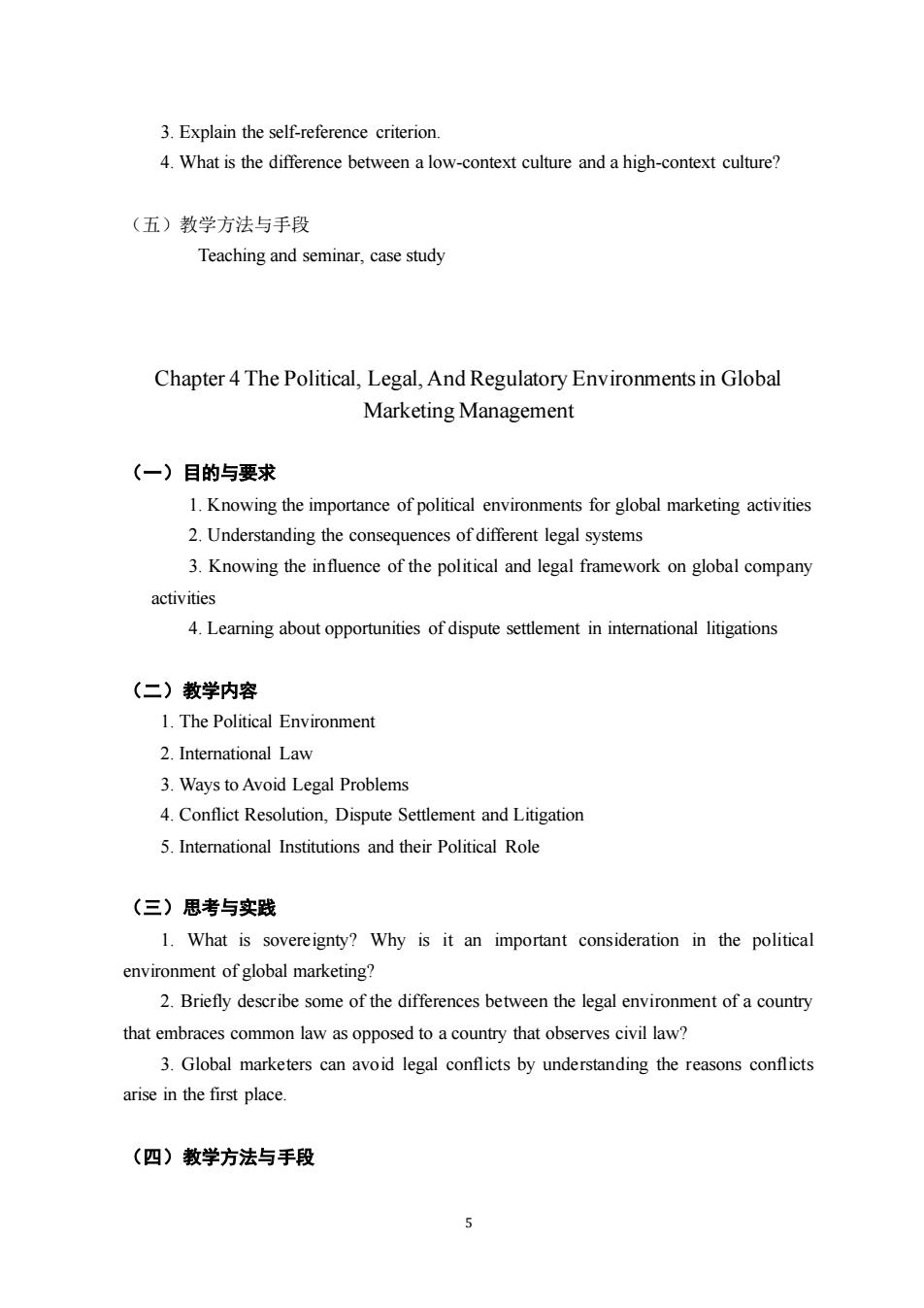
3.Explain the self-reference criterion. 4.What is the difference between a low-context culture and a high-context culture? (五)教学方法与手段 Teaching and seminar,case study Chapter 4 The Political,Legal,And Regulatory Environments in Global Marketing Management (一)目的与要求 1.Knowing the importance of political environments for global marketing activities 2.Understanding the consequences of different legal systems 3.Knowing the influence of the political and legal framework on global company activities 4.Leaming about opportunities of dispute settlement in intemational litigations (二)教学内容 1.The Political Environment 2.International Law 3.Ways to Avoid Legal Problems 4.Conflict Resolution,Dispute Settlement and Litigation 5.International Institutions and their political role (三)思考与实践 1.What is sovereignty?Why is it an important consideration in the political environment of global marketing? 2.Briefly describe some of the differences between the legal environment of a country that embraces common law as opposed to a country that observes civil law? 3.Global marketers can avoid legal conflicts by understanding the reasons conflicts arise in the first place (四)教学方法与手段
5 3. Explain the self-reference criterion. 4. What is the difference between a low-context culture and a high-context culture? (五)教学方法与手段 Teaching and seminar, case study Chapter 4 The Political, Legal, And Regulatory Environments in Global Marketing Management (一)目的与要求 1. Knowing the importance of political environments for global marketing activities 2. Understanding the consequences of different legal systems 3. Knowing the influence of the political and legal framework on global company activities 4. Learning about opportunities of dispute settlement in international litigations (二)教学内容 1. The Political Environment 2. International Law 3. Ways to Avoid Legal Problems 4. Conflict Resolution, Dispute Settlement and Litigation 5. International Institutions and their Political Role (三)思考与实践 1. What is sovereignty? Why is it an important consideration in the political environment of global marketing? 2. Briefly describe some of the differences between the legal environment of a country that embraces common law as opposed to a country that observes civil law? 3. Global marketers can avoid legal conflicts by understanding the reasons conflicts arise in the first place. (四)教学方法与手段
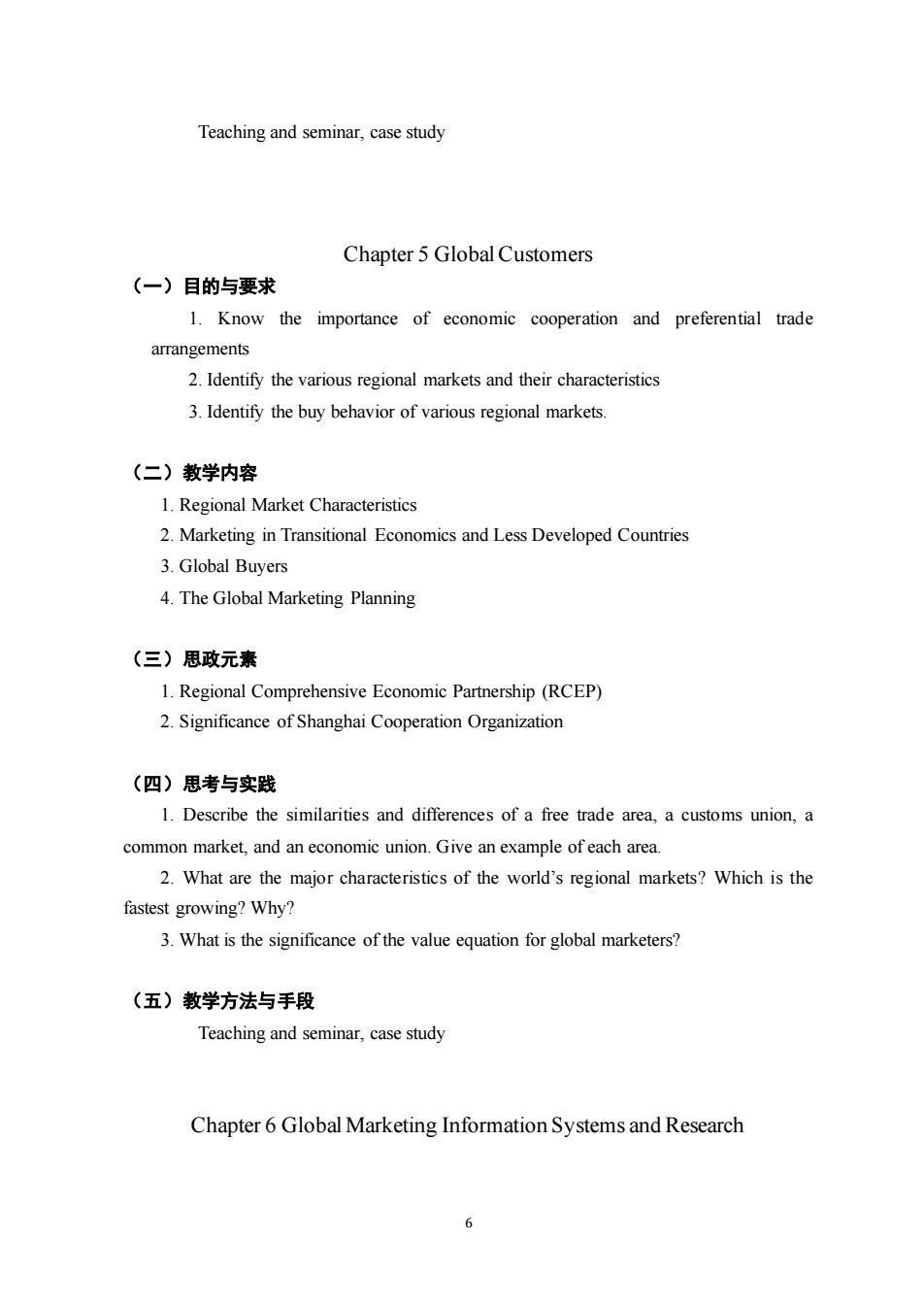
Teaching and seminar,case study Chapter 5 Global Customers (一)目的与要求 1.Know the importance of economic cooperation and preferential trade arrangements 2.Identify the various regional markets and their characteristics 3.Identify the buy behavior of various regional markets. (二)教学内容 1.Regional Market Characteristics 2.Marketing in Transitional Economics and Less Developed Countries 3.Global Buyers 4.The Global Marketing Planning (三)思政元素 1.Regional Comprehensive Economic Partnership(RCEP) 2.Significance of Shanghai Cooperation Organization (四)思考与实践 1.Describe the similarities and differences of a free trade area,a customs union,a common market,and an economic union.Give an example of each area. 2.What are the major characteristics of the world's regional markets?Which is the fastest growing?Why? 3.What is the significance of the value equation for global marketers? (五)教学方法与手段 Teaching and seminar,case study Chapter 6 Global Marketing Information Systems and Research 6
6 Teaching and seminar, case study Chapter 5 Global Customers (一)目的与要求 1. Know the importance of economic cooperation and preferential trade arrangements 2. Identify the various regional markets and their characteristics 3. Identify the buy behavior of various regional markets. (二)教学内容 1. Regional Market Characteristics 2. Marketing in Transitional Economics and Less Developed Countries 3. Global Buyers 4. The Global Marketing Planning (三)思政元素 1. Regional Comprehensive Economic Partnership (RCEP) 2. Significance of Shanghai Cooperation Organization (四)思考与实践 1. Describe the similarities and differences of a free trade area, a customs union, a common market, and an economic union. Give an example of each area. 2. What are the major characteristics of the world’s regional markets? Which is the fastest growing? Why? 3. What is the significance of the value equation for global marketers? (五)教学方法与手段 Teaching and seminar, case study Chapter 6 Global Marketing Information Systems and Research
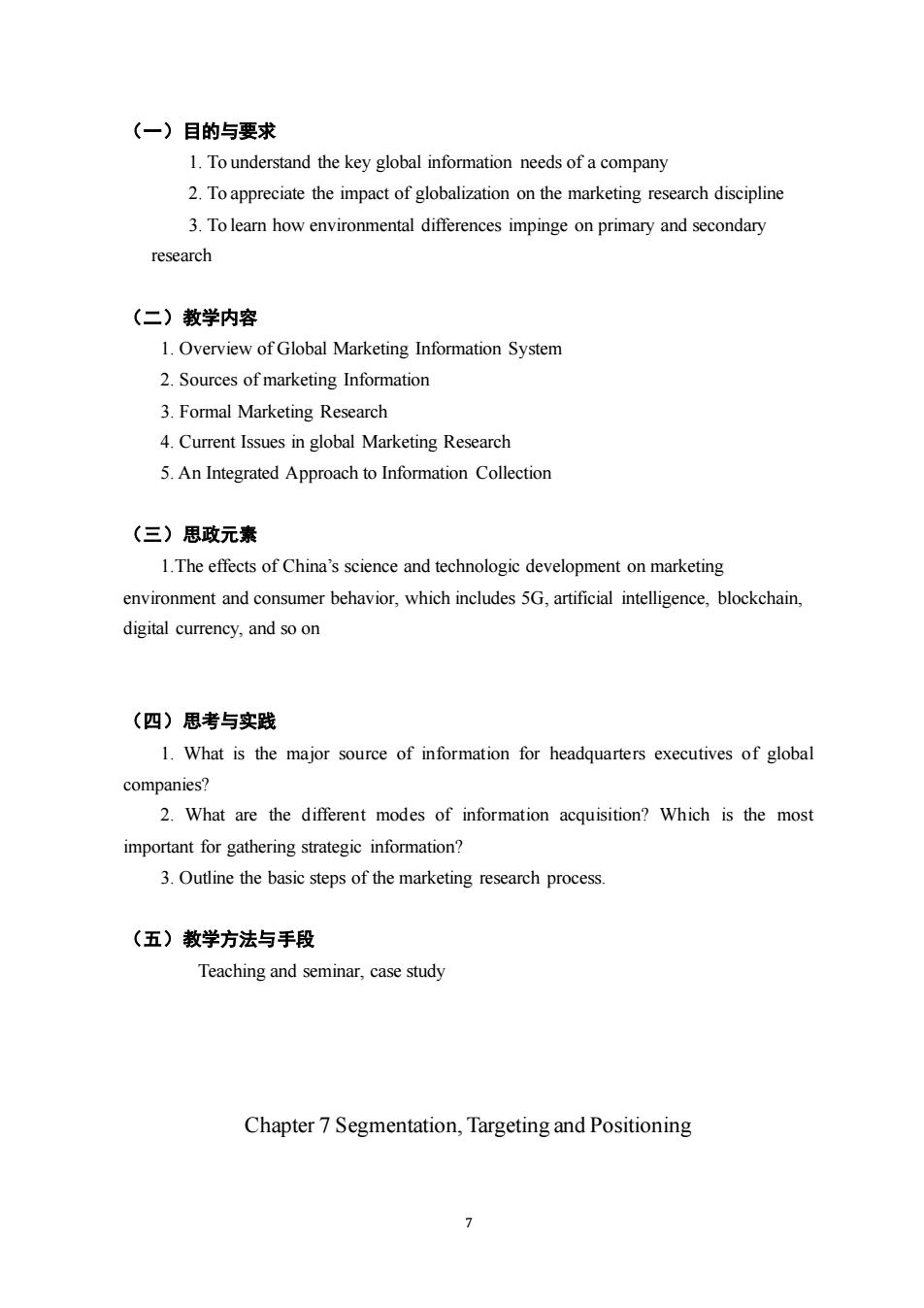
(一)目的与要求 1.To understand the key global information needs of a company 2.To appreciate the impact of globalization on the marketing research discipline 3.To learn how environmental differences impinge on primary and secondary research (二)教学内容 1.Overview of Global Marketing Information System 2.Sources of marketing Information 3.Formal Marketing Research 4.Current Issues in global Marketing Research 5.An Integrated Approach to Information Collection (三)思政元素 1.The effects of China's science and technologic development on marketing environment and consumer behavior,which includes 5G,artificial intelligence,blockchain, digital currency,and so on (四)思考与实践 1.What is the major source of information for headquarters executives of global companies? 2.What are the different modes of information acquisition?Which is the most important for gathering strategic information? 3.Outline the basic steps of the marketing research process. (五)教学方法与手段 Teaching and seminar,case study Chapter 7 Segmentation,Targeting and Positioning
7 (一)目的与要求 1. To understand the key global information needs of a company 2. To appreciate the impact of globalization on the marketing research discipline 3. To learn how environmental differences impinge on primary and secondary research (二)教学内容 1. Overview of Global Marketing Information System 2. Sources of marketing Information 3. Formal Marketing Research 4. Current Issues in global Marketing Research 5. An Integrated Approach to Information Collection (三)思政元素 1.The effects of China’s science and technologic development on marketing environment and consumer behavior, which includes 5G, artificial intelligence, blockchain, digital currency, and so on (四)思考与实践 1. What is the major source of information for headquarters executives of global companies? 2. What are the different modes of information acquisition? Which is the most important for gathering strategic information? 3. Outline the basic steps of the marketing research process. (五)教学方法与手段 Teaching and seminar, case study Chapter 7 Segmentation, Targeting and Positioning
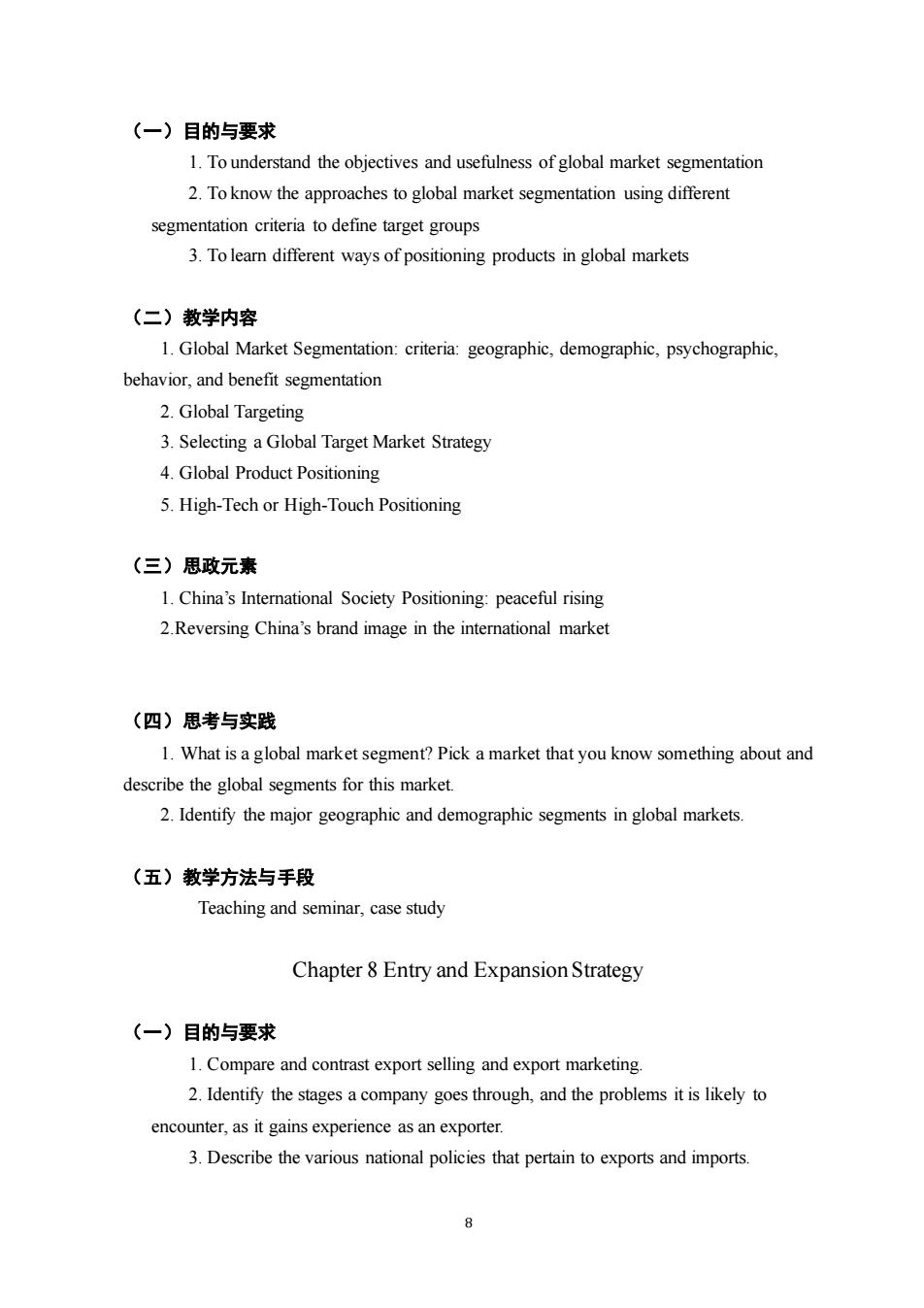
(一)目的与要求 1.To understand the objectives and usefulness of global market segmentation 2.To know the approaches to global market segmentation using different segmentation criteria to define target groups 3.To learn different ways of positioning products in global markets (二)教学内容 1.Global Market Segmentation:criteria:geographic,demographic,psychographic behavior,and benefit segmentation 2.Global Targeting 3.Selecting a Global Target Market Strategy 4.Global Product Positioning 5.High-Tech or High-Touch Positioning (三)思政元素 1.China's International Society Positioning:peaceful rising 2.Reversing China's brand image in the intemational market (四)思考与实践 1.What is a global market segment?Pick a market that you know something about and describe the global segments for this market. 2.Identify the major geographic and demographic segments in global markets (五)教学方法与手段 Teaching and seminar,case study Chapter8 Entry and Expansion Strategy (一)目的与要求 1.Compare and contrast export selling and export marketing. 2.Identify the stages a company goes through,and the problems it is likely to encounter,as it gains experience as an exporter. 3.Describe the various national policies that pertain to exports and imports 8
8 (一)目的与要求 1. To understand the objectives and usefulness of global market segmentation 2. To know the approaches to global market segmentation using different segmentation criteria to define target groups 3. To learn different ways of positioning products in global markets (二)教学内容 1. Global Market Segmentation: criteria: geographic, demographic, psychographic, behavior, and benefit segmentation 2. Global Targeting 3. Selecting a Global Target Market Strategy 4. Global Product Positioning 5. High-Tech or High-Touch Positioning (三)思政元素 1. China’s International Society Positioning: peaceful rising 2.Reversing China’s brand image in the international market (四)思考与实践 1. What is a global market segment? Pick a market that you know something about and describe the global segments for this market. 2. Identify the major geographic and demographic segments in global markets. (五)教学方法与手段 Teaching and seminar, case study Chapter 8 Entry and Expansion Strategy (一)目的与要求 1. Compare and contrast export selling and export marketing. 2. Identify the stages a company goes through, and the problems it is likely to encounter, as it gains experience as an exporter. 3. Describe the various national policies that pertain to exports and imports

4.Explain the structure of the Harmonized Tariff System. 5.Identify the factors that global marketers consider when making sourcing decisions (二)教学内容 1.The need for a solid market entry decision is an integral part ofa global market entry strategy. 2.Entry decisions will heavily influence the firm's other marketing-mix decisions 3.Global marketers have to make a multitude of decisions regarding the entry mode (三)思政元素 1.The significance of Nixon's trip to China in 1972 and China's entry into wester markets 2.Chllenges faced by China's MNCs in the international markets nowadays,such as USA's sanction against Huawei,Tik Tok,etc. (四)思考与实践 1.What are the advantages and disadvantages of a joint venture as a global market-entry tool? 2.Explain the advantages and disadvantages of using a contract manufacturer. (五)教学方法与手段 Teaching and seminar,case study Chapter 9 Cooperative Strategy and Global Strategic Partnerships (一)目的与要求 1.Understand the importance of cross border strategic alliances as an international cooperative strategy 2.Describe cooperative strategies'risks. 3.Describe two approaches used to manage cooperative strategies (二)教学内容 9
9 4. Explain the structure of the Harmonized Tariff System. 5. Identify the factors that global marketers consider when making sourcing decisions (二)教学内容 1. The need for a solid market entry decision is an integral part of a global market entry strategy. 2. Entry decisions will heavily influence the firm’s other marketing-mix decisions. 3. Global marketers have to make a multitude of decisions regarding the entry mode (三)思政元素 1.The significance of Nixon’s trip to China in 1972 and China’s entry into western markets 2.Chllenges faced by China’s MNCs in the international markets nowadays, such as USA’s sanction against Huawei, Tik Tok, etc. (四)思考与实践 1. What are the advantages and disadvantages of a joint venture as a global market-entry tool? 2. Explain the advantages and disadvantages of using a contract manufacturer. (五)教学方法与手段 Teaching and seminar, case study Chapter 9 Cooperative Strategy and Global Strategic Partnerships (一)目的与要求 1. Understand the importance of cross border strategic alliances as an international cooperative strategy. 2. Describe cooperative strategies’ risks. 3. Describe two approaches used to manage cooperative strategies. (二)教学内容

1.Define cooperative strategies explain why firms use them. 2.Define&discuss three types of strategic alliances. 3.Name the business-level cooperative strategies&describe their use 4.Discuss the use of corporate-level cooperative strategies&describe their use (三)思政元素 1.The cooperative and competitive relationship between China and USA 2.China's win-win cooperation initiative and"one belt,one road" (四)思考与实践 1.What are the pre-context of cooperative strategies? 2.Can firms from different countries and different industries successfully cooperate? (五)教学方法与手段 Teaching and seminar,case study Chapter 10 Competitive Analysis and Strategy (一)目的与要求 1.Identify the factors contribute to industrial competition 2.Know about the competition models and strategic positions 3.Understand the national competitive advantages (二)教学内容 1.Industry analysis forces influencing competition 2.Global competition and national competitive advantages 3.Competitive advantages and strategic models 4.Competitive innovation and strategic intent (三)思政元素 1.The nature of Sino-US competition 2.Three business card of"made in China":high-speed railway,China Aerospace,and 10
10 1. Define cooperative strategies & explain why firms use them. 2. Define & discuss three types of strategic alliances. 3. Name the business-level cooperative strategies & describe their use. 4. Discuss the use of corporate-level cooperative strategies & describe their use. (三)思政元素 1. The cooperative and competitive relationship between China and USA 2. China’s win-win cooperation initiative and “one belt, one road” (四)思考与实践 1. What are the pre-context of cooperative strategies? 2. Can firms from different countries and different industries successfully cooperate? (五)教学方法与手段 Teaching and seminar, case study Chapter 10 Competitive Analysis and Strategy (一)目的与要求 1. Identify the factors contribute to industrial competition 2. Know about the competition models and strategic positions 3. Understand the national competitive advantages (二)教学内容 1. Industry analysis forces influencing competition 2. Global competition and national competitive advantages 3. Competitive advantages and strategic models 4. Competitive innovation and strategic intent (三)思政元素 1.The nature of Sino-US competition 2.Three business card of “made in China”: high-speed railway, China Aerospace, and